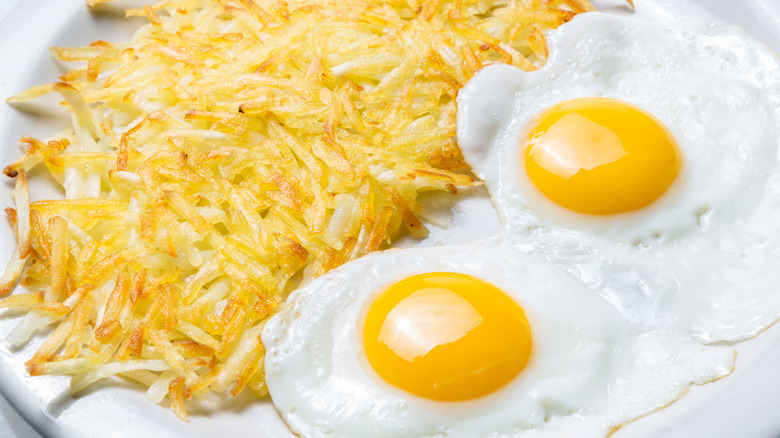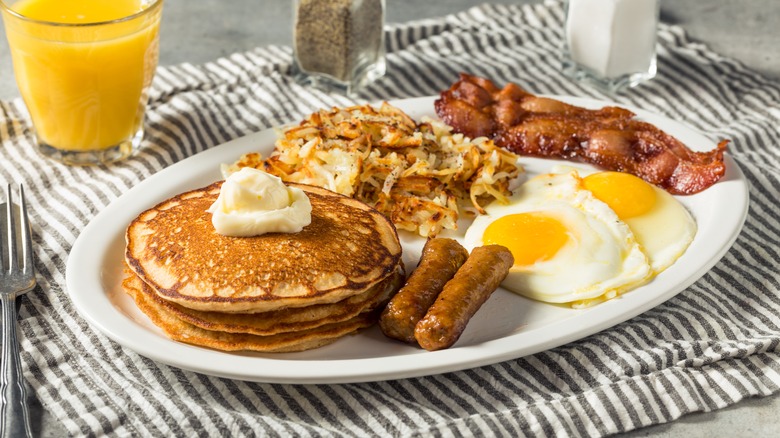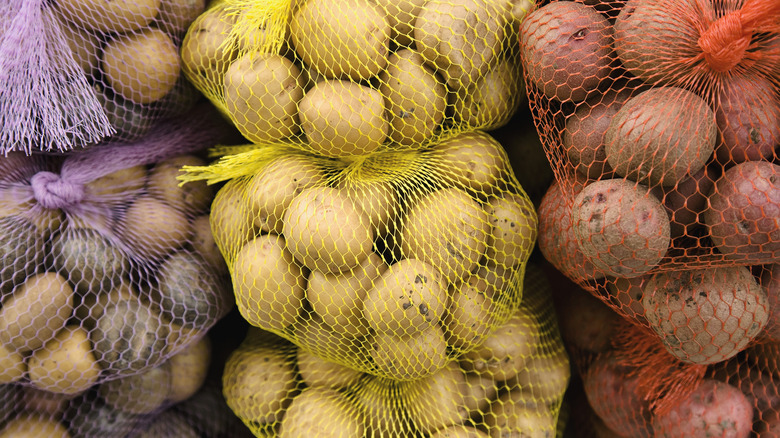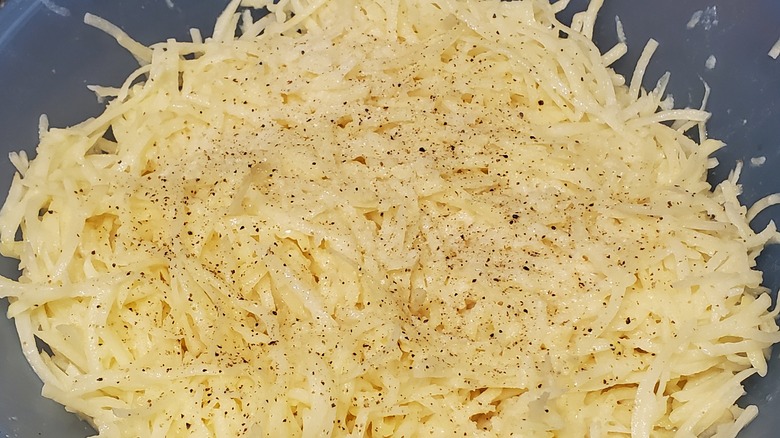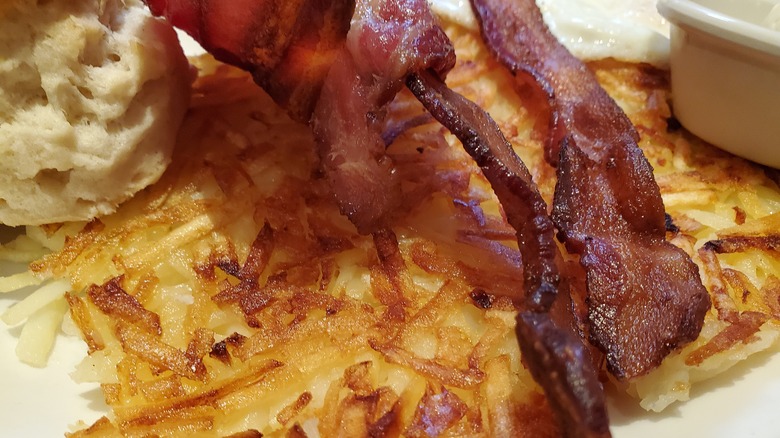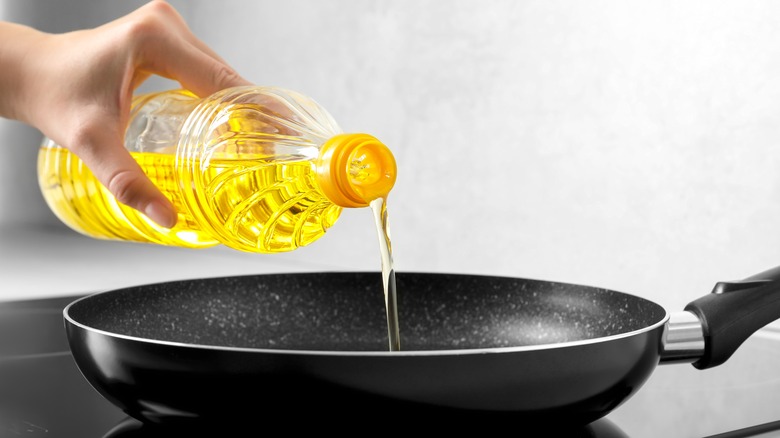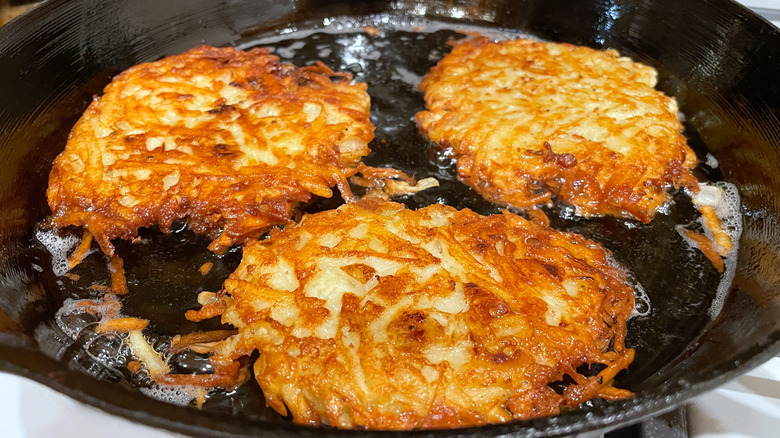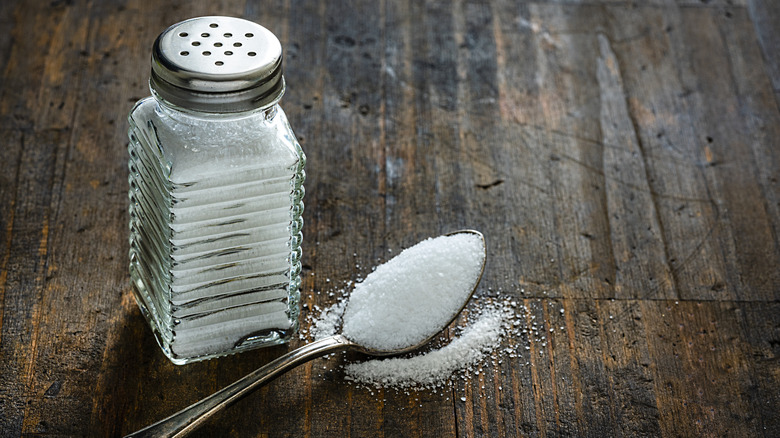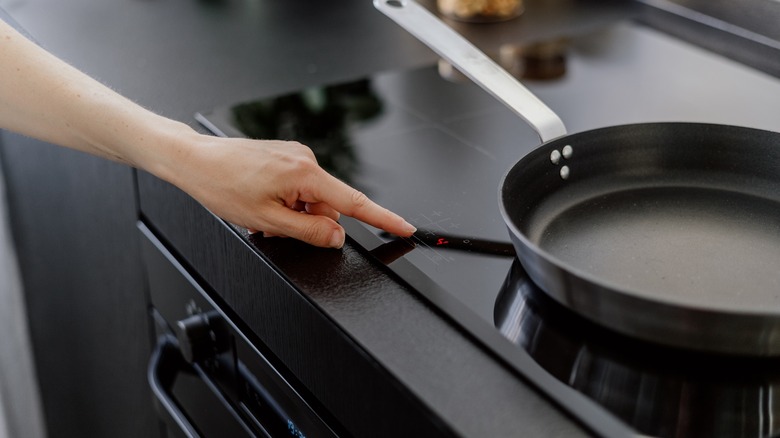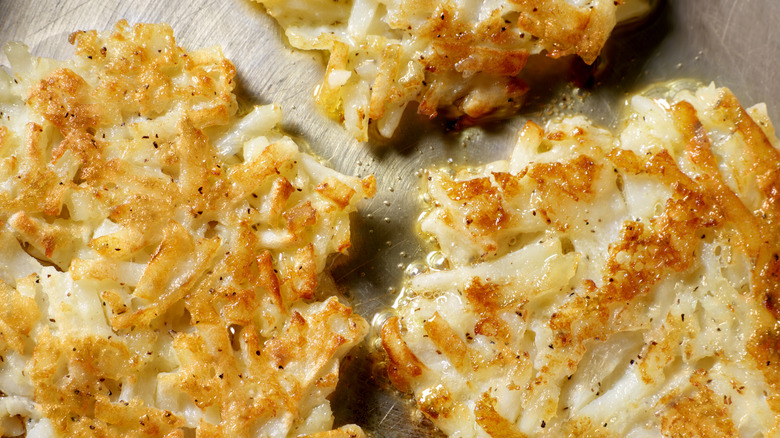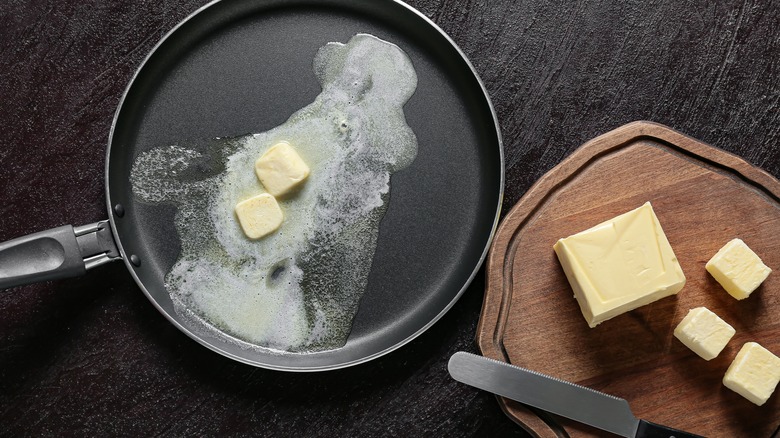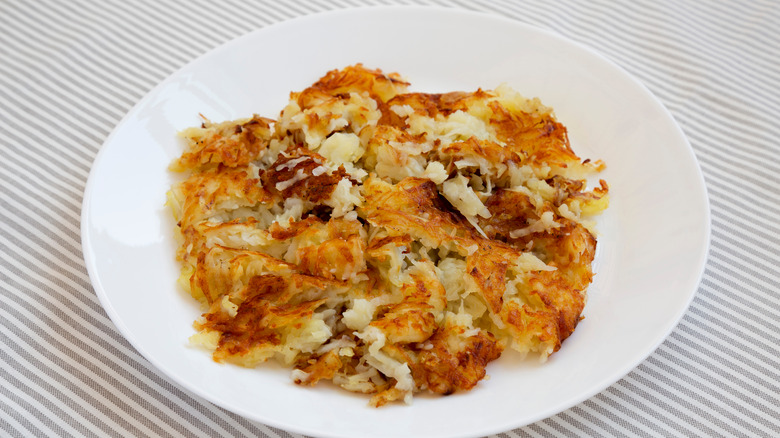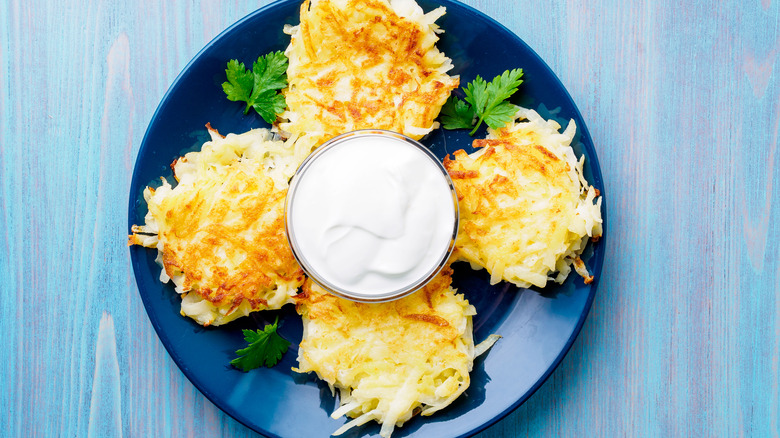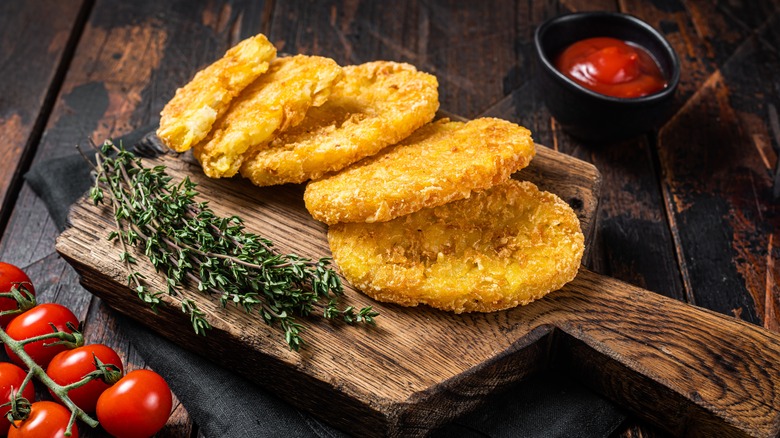Mistakes Everyone Makes With Hash Browns
Hash browns are one of life's simple pleasures. If you're a morning person, their crispy goodness is just one more reason to look forward to getting out of bed. And if only the clanking of pots and pans will wake you before noon, hash browns are a greasy delicious consolation for having to start your day at an unnatural hour. Whether you use them to soak up the yolk of your sunny-side-up egg or as a starchy foil for that last bit of bacon, they're a dependable treat — golden and crunchy on the outside, tender and hearty on the inside.
But if you've ever tried making hash browns at home, you may have found they're anything but dependable. What seems so straightforward for every entry-level fry cook — toss some chopped or shredded potatoes onto a griddle, fry, flip, and serve — becomes a baffling struggle for even experienced home chefs. Potatoes stubbornly stick to the pan, or they turn weirdly gray. They might even refuse to brown altogether, devolving into soggy mush — but it doesn't have to be like that. With a few simple techniques, you too can avoid mistakes and crack the code to making perfect hash browns.
Cutting your potatoes into the wrong shapes
No batch of hash browns can be considered a success unless it brings some serious crunch. And to get that, you need not only the right amount of heat and fat, but the right shape for your potato bits — to maximize crunch, you need to maximize the surface area exposed to the cooking fat, which will help you get lots of satisfyingly crunchy munchy edges.
And the right shape is the one almost certainly used in your favorite diner – long, coarse shreds. There's a reason this is the go-to shape for hash browns. First, if you have a food processor with a disc attachment, they're a snap to make. (If you don't, the large holes on a box grater work too.) Second, they hold together well in a frying pan or on a griddle. And finally, and most importantly, they offer a multitude of little surfaces that can crisp up easily in hot cooking fat, creating that crispy, craggy texture we all love.
Using the wrong potatoes
Successful execution of any recipe starts with choosing the right ingredients. And in a dish like hash browns, where potatoes are front and center, this means ensuring you choose the right potatoes. Believe it or not, they're not all created equal — the right potato type can give you the solid crunch you want, while the wrong choice can leave you with wan, soggy results.
To get that crunch and golden color, you need potatoes with a good amount of starch. An easy-to-find variety that works well for hash browns is the russet, the classic baking potato – its rough skin and mealy texture when cooked are telltale signs of high starch content. In contrast, potatoes with smooth skins that have a smoother texture when cooked (such as red potatoes) are low starch, or waxy, potatoes. While great in potato salads, they have a higher moisture content than their starchy relatives and won't fry up with the same crunch. If you can't find russets, look for another rough-skinned variety.
Not rinsing your potatoes
While starchy potatoes are a must for successful hash browns, it's possible to have too much of a good thing. The right amount of starch is essential for an optimal balance between crunch and tenderness. But too much surface starch can result in a gray, undercooked interior — yuck. This is because potato starch oxidizes when exposed to air (that is, when potatoes are peeled or cut), causing the exposed flesh to turn brown or gray. In addition, excess starch prevents hash browns from cooking through properly, resulting in unappetizing raw bits.
To keep your potatoes attractively pale as you shred them, try shredding them directly into a bowl of water (or covering them with water as soon as they're shredded). And to get rid of excess starch, thoroughly rinse your shredded potatoes – ideally, you should cover them completely with water and stir them around vigorously before draining them. There will still be enough starch to get you the crunchiness you crave — but not enough to turn your potatoes gray or weirdly textured.
Trying to fry wet potatoes
Hash browns are a fundamentally simple preparation — nothing more than shredded, fried potatoes, maybe with a few add-ins such as shredded onions thrown in. But as is the case with many superficially simple recipes, the devil's in the details: Every step must be executed perfectly for the dish to be successful. And in the case of hash browns, this can include steps many of us probably hadn't even thought of — such as rinsing the potatoes.
Related to this is another essential step for hash brown success: thoroughly drying your potatoes before frying them up. This will ensure that your potatoes will indeed fry and crisp up properly, rather than steam (or worse, stick to the pan). But if you've taken care to rinse your potatoes after shredding them, they will be thoroughly wet, which means drying them will require aggressive action. The most efficient way to handle this is to drain your shredded potatoes, wrap them in a clean, lint-proof towel, and working over the sink, squeeze them hard multiple times to wring out as much water as possible.
Using the wrong pan
There's nothing more frustrating than patiently waiting for that nice, brown crust to form on the bottom of your hash browns, only to find that it stubbornly refuses to release itself from the pan. A number of factors can contribute to sticking, from cooking temperature to technique to wet potatoes. And while impeccable cooking technique is an excellent way to ensure your potatoes don't stick, mastering this requires time and practice (and potentially, a lot of wasted potatoes). An easier way to failsafe your efforts is to start with the right pan – a good, non-stick skillet.
For some serious home cooks, the idea of using a nonstick pan may feel a bit like cheating, but there's no disgrace in this. It will help you achieve solid results – that is, potatoes with a nice, evenly gold crust that will slide intact onto a serving platter — even if your technique is less than perfect. But if you're a traditionalist, a well-seasoned cast-iron pan is another good option that will give you crunch with a fairly low chance of sticking.
Moving your potatoes around while frying
For dedicated home cooks, sometimes the hardest thing to do is nothing. If you enjoy feeling productive in the kitchen and love the sensation of prepping and cooking food, just standing around and waiting for your food to cook or bake can feel frustrating and unproductive. But it's important to trust the process — because it's during these lulls in activity when food transforms from a mere collection of ingredients into a perfectly cooked dish.
Cooking hash browns is a case in point. After you've meticulously shredded, rinsed, and dried your potatoes — and put them into a hot pan with your cooking fat – your next critical move is to stand back and leave them alone. This is because the potatoes will need a period of uninterrupted exposure to the hot fat to cook through and develop a good crisp crust. Trying to move them around before this has happened will result in half-cooked potatoes sticking to the pan, and this won't be pretty. So even if it's an old habit, avoid the temptation to keep stirring your hash browns as they cook — you'll not only save yourself work and stress, but get tastier results.
Seasoning at the wrong time
One reason hash browns are so appealing is that they play well with other foods — mild and neutral in flavor, they're an ideal backdrop for rich egg dishes and bold breakfast meats. But mild as they are, they should never be bland — a forkful of hash browns should have enough flavor to make good eating by itself. It doesn't take much to take a pan of hash browns from flavorless to fabulous — just a bit of salt and pepper will do the trick — but an often-overlooked secret to success is knowing when to add your seasonings.
Timing matters because of the way salt interacts with food. It has a tendency to draw water out of food (this is why it's used to wilt vegetables and in making dried preparations such as beef jerky), so it's not a good idea to salt potatoes for hash browns before they're cooked — this will make them release water and steam instead of frying up crisp. Sprinkling on salt after the hash browns are done isn't a perfect solution either — you'll end up with hash browns with a salty crust and bland interior. The sweet spot is when the potatoes are halfway cooked – sprinkle on the salt and pepper when the bottom crust is cooked through, just before you flip the hash browns.
Not preheating the pan
Looking at a dish of hash browns, you'd think they'd be the easiest thing in the world to make — just shred up some potatoes, toss them into an oiled pan, and crank up the heat. But anyone who tries to make them this way will end up with a sticky, soggy mess. Hash browns may be a simple dish, but the techniques for getting them right are far from obvious. And many home cooks simply lay their hash browns in a pan that hasn't hit the right temp.
So, among the critical approaches for a great batch of hash browns is ensuring your pan is good and hot before you toss in the potatoes. This will help prevent sticking by ensuring your potatoes start to fry immediately, rather than just absorb cold oil. (This principle holds for other fried foods as well.) And even if you've already minimized the risk of sticking by using a nonstick pan, starting your potatoes in a hot pan will give you a better crunch and less-greasy potatoes — a double win!
Frying at the wrong temperature
A properly made batch of hash browns is all about balance and contrast — you want crispy outsides and tender, just-cooked insides. But if you've been focusing all your efforts on getting that great golden crust, you might be overlooking the second half of the equation: Frying your hash browns over consistently high heat may give you a beautiful exterior, but leave you with unappetizing raw shreds on the inside. But cooking them over low heat will not only take forever, it'll give you less-than-optimal results. What's a hungry cook to do?
The secret to success is to split the difference: You want that high heat to set the crust — but also need lower heat to ensure the potatoes have time to cook all the way through without the crust burning. So you'll need to adjust the heat as you cook: Heat the pan to high, add your potatoes, then drop the heat to medium high. This will give you enough heat to build up a crispy exterior while allowing the insides to become meltingly tender.
Frying in non-clarified butter
You have a lot of choices when it comes to cooking oils for your hash browns. Neutrally flavored oils with high smoke points, such as vegetable, sunflower, or grape seed oils, are always safe bets and allow the flavor of the potatoes to shine through clearly. Extra-virgin olive oil can add a lot of flavor, but its lower smoke point makes it more susceptible to burning — so should be used with caution (if at all) when making hash browns.
If you're in the mood for extra-decadent hash browns, butter is another option. But while it adds a whole lot of flavor and richness, it also browns quickly and runs a huge risk of burning before your potatoes are close to done. To get all the flavor of butter without the ugly burnt bits overcooked butter can produce, use clarified butter, or ghee – this is butter with all its fast-burning milk solids removed. To clarify your own butter, simply heat it and skim the white foamy stuff off the top, leaving only clear, yellow butter behind.
Pressing down on your potatoes while they're frying
Have you ever encountered an eager little kid who wanted nothing more than to be helpful in the kitchen, but only ended up getting in the way and making everything worse? If so, you know how frustrating it is to cope with their well-intended (but counterproductive) help. And if hash browns had feelings, that's probably how they'd feel about you smashing down on them with a spatula as they cook. Even if that's how your mom and grandmother did it, the reality is you're in the way of your hash browns reaching their full potential.
So why is squashing hash browns such a bad thing? For one, you'll be ruining their texture. Part of the appeal of hash browns is how the crust has lots of crunchy little edges and nubs and the interior flakes apart as you cut and eat it — pressing your hash browns will yield a boring, dense, flat mass instead. Second, pressing them will interfere with the formation of the crust and increase the chance of sticking. And third, besides being counterproductive, it's more work for you, and with all the other steps you need to follow to make great hash browns, you've already got enough on your plate. So put down that spatula and just trust the process. You'll be pleasantly surprised.
Serving hash browns the same way every time
We totally get that a big part of the appeal of hash browns is their familiarity: Once you get a batch cooking, you know exactly how great it will taste alongside your favorite eggs and bacon/sausage/ham. And there's no denying this is a classic combo that deserves serious respect. But if you're making hash browns the right way, you owe it to yourself to explore their full potential. Because hash browns are a fundamentally neutral-tasting dish, they lend themselves to a range of flavor profiles, some of which may surprise you.
For instance, there's no reason hash browns have to be savory. Just as potato pancakes can be served with sweet applesauce, hash browns can be served with a topping of sliced apples or a dollop of ricotta and a drizzle of honey. But if you want to stay on the savory side, you can dress hash browns up with lox or a topping of shredded nori and sriracha. And instead of the standard Cheddar or American cheese topper, try another cheese such as Parmesan or even blue cheese. Also, they're not just for breakfast — make hash browns the base of a hearty dinner with a topping of stew or chili.
Overlooking frozen options
Hash browns seem like such an easy dish when you get them at a restaurant — a cook casually tosses a handful of shredded potatoes onto a griddle, flips them over once they've browned on one side, then slides them onto your plate when they're ready. Making them at home, however, is more complicated. Prepping the potatoes, timing your cooking — it can be a lot. But guess what? You have permission to cheat.
Frozen hashbrowns — choose the shredded, not cubed ones – will work just fine, and good brands fry up and crisp evenly and consistently. Not only will they save you the trouble of shredding potatoes, but of soaking and drying them. But if the idea of additives and artificial ingredients in frozen hash browns gives you pause, remember that you've probably been consuming these with every dish of chain-coffee-shop hash browns you've ever eaten — they're made with industrially produced, dehydrated potato shreds that are sort of restored before use. And if you consider coffee shop hash browns a taste of your childhood, you might find that frozen spuds satisfy your hash brown itch better than even the most perfectly rendered-from-scratch version ever will.

